 As with much of life, it is all about achieving balance; finding harmony between two opposing points. Too often, balance is elusive and, perhaps, perfect balance is unattainable. Yet, we would all agree it is a worthy goal. Balance might even be considered laughable in the context of a C-level executive, but that’s precisely what Antonio Capaldo, Chairman of Feudi di San Gregorio, strives to achieve. At a recent dinner, he continually circled back to this word – and to this concept of striking a balance between competing polarities and viewpoints – all to the good of his company and the wines it produces.
As with much of life, it is all about achieving balance; finding harmony between two opposing points. Too often, balance is elusive and, perhaps, perfect balance is unattainable. Yet, we would all agree it is a worthy goal. Balance might even be considered laughable in the context of a C-level executive, but that’s precisely what Antonio Capaldo, Chairman of Feudi di San Gregorio, strives to achieve. At a recent dinner, he continually circled back to this word – and to this concept of striking a balance between competing polarities and viewpoints – all to the good of his company and the wines it produces.
Situated within the Italian region of Campania, home to Naples and the Amalfi Coast, Feudi di San Gregorio was established in 1986, although winemaking in the region dates back to the 12th century BCE, influenced by the Greeks, Romans and Byzantines. Capaldo joined the family business in 2009 after a decade-long career in finance and management consulting, having earned a PhD in Economics and Finance from a joint program between London School of Economics and University of Rome. Concurrently, he balanced his time between work and “play”, successfully pursuing his sommelier certification, thus bringing the dual perspectives of business acumen and wine knowledge to his role.
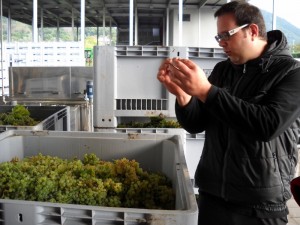 At a production of 3.5 million bottles annually, today, Feudi is the largest winery in Southern Italy, excluding Sicily. Yet, in spite of its size relative to its neighbors, it is still considered to be medium in size. It is this balance between being an artisanal producer and a large corporation, that Capaldo attributes to their success. In this regard, they have the resources to continually learn and evolve and pass that knowledge down to subsequent generations as well as the advantage of being more than one person’s impact or vision. Simultaneously, they are small enough to be nimble and responsive to the market.
At a production of 3.5 million bottles annually, today, Feudi is the largest winery in Southern Italy, excluding Sicily. Yet, in spite of its size relative to its neighbors, it is still considered to be medium in size. It is this balance between being an artisanal producer and a large corporation, that Capaldo attributes to their success. In this regard, they have the resources to continually learn and evolve and pass that knowledge down to subsequent generations as well as the advantage of being more than one person’s impact or vision. Simultaneously, they are small enough to be nimble and responsive to the market.
Their size has also given them the opportunity to drive quality throughout the region. Having brought in the expertise of Simonit and Sirch, they instituted a pruning school for local growers (Feudi buys 30-40% of its grapes) and have dramatically shifted the way in which they pay them. Specifically, they no longer reward growers for volume, instead paying them based on the quality of the fruit they deliver. In order to do so, they balance the risk and reward, overcoming the growers’ objectives to keeping grapes on the vine longer due to threat of rain or other weather hazards. While this has been an expensive proposition, the quality of the grapes has vastly improved.
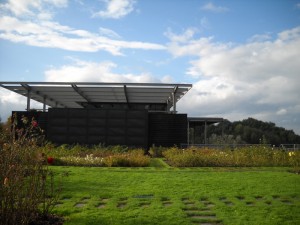 Balance is also extremely important when discussing the impact of hospitality at the winery. Capaldo notes that world class hospitality is vital to the winery, especially given its proximity to such tourist destinations as Positano and Pompeii, and it now welcomes 40,000 visitors each year. While many of them come expressly for the wine, others are drawn to the winery’s Michelin-starred restaurant and only later discover that it is connected to the winery. Consequently, while winery tours should extoll the virtues of the winery’s restaurant, world-class architectural design and esteemed collection of artwork, their tour guides must be equally trained (and remember) to speak about the winery and its wines.
Balance is also extremely important when discussing the impact of hospitality at the winery. Capaldo notes that world class hospitality is vital to the winery, especially given its proximity to such tourist destinations as Positano and Pompeii, and it now welcomes 40,000 visitors each year. While many of them come expressly for the wine, others are drawn to the winery’s Michelin-starred restaurant and only later discover that it is connected to the winery. Consequently, while winery tours should extoll the virtues of the winery’s restaurant, world-class architectural design and esteemed collection of artwork, their tour guides must be equally trained (and remember) to speak about the winery and its wines.
Capaldo further underscores the need for balance in the vineyard. When answering a question about sustainable practices, he acknowledges that while they aspire to be organic, the climate makes this impossible to commit to fully. Accordingly, their philosophy is to be sustainable in all things – with a decided emphasis on sustaining the vines themselves. In this regard, he notes that there is often a need to replant every 30 years or so in organically-certified vineyards. With so many historic vines under his purview – Capaldo proudly shared a photo of the 100+ year-old vines in the Serpico vineyard – he feels the duty to preserve vines not just for decades, but for centuries.
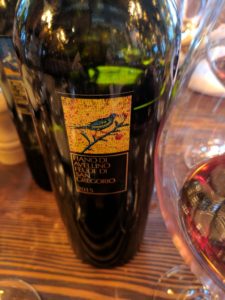 Vinously, the winery provides a balance in the 25 or so wines it creates, offering up the popular and approachable Falanghina, alongside the more structured Greco di Tufo and Fiano d’Avellino wines. Capaldo also balances the need to age the reds for long periods of time before release (adding to his expense and the wine’s price) with getting the wines into the market. But, errs on the side of quality, choosing to age his wines longer than the denomination rules require.
Vinously, the winery provides a balance in the 25 or so wines it creates, offering up the popular and approachable Falanghina, alongside the more structured Greco di Tufo and Fiano d’Avellino wines. Capaldo also balances the need to age the reds for long periods of time before release (adding to his expense and the wine’s price) with getting the wines into the market. But, errs on the side of quality, choosing to age his wines longer than the denomination rules require.
Personally, Capaldo admits that balance is hard. He recognizes that he comes from a background of control and is aiming to do a better job of letting go – taking time for family, allowing others to handle various business matters and letting go of the things beyond his control such as vintage variations and their impact on the wines. Watching him during dinner, it is clear that he practices what he preaches, finding a balance in all things: his wife had accompanied him on this trip (and to the dinner), he carefully selected gluten-free options, barely touched his wines and finished his meal with a decadent chocolate dessert!
TASTING NOTES
When we speak of a great glass of wine, we frequently consider the balance between fruit and tannins, between sweetness and acidity and in not having too much oak or alcohol. The wines of Feudi definitely deliver in being well-balanced wines. My tasting notes are a bit sparse from the evening, but it was a pleasure to be reacquainted with these wines I had last tasted in June 2016.
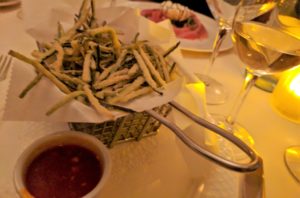 Feudi di San Gregorio Sannio Falanghina DOC 2017, Campania, Italy
Feudi di San Gregorio Sannio Falanghina DOC 2017, Campania, Italy
Fresh fruit and floral aromas and flavors, with nice acidity, medium body and just generally easy and fun to drink.
Feudi di San Gregorio Greco di Tufo DOCG 2017, Campania, Italy
Grown in high elevation vineyards, the fruit is all hand harvested due to the steep terrain. Despite the lack of oak or skin contact, Greco produces structured wines, with limited fruit character and a beautiful ability to pair well at the table. I enjoyed it equally with the fried zucchini as I did with the duck breast.
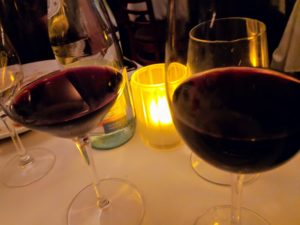 Feudi di San Gregorio Taurasi DOCG 2013, Campania, Italy
Feudi di San Gregorio Taurasi DOCG 2013, Campania, Italy
This wine spends 18 months in oak with another 9 months in bottle. It displayed lots of bright acidity, with aromas and flavors of cherry, spice and other red fruit, with firm tannins on the full-bodied palate. It was easier to drink than the Riserva 2012 but I would appreciate it more in the future, when the tannins will have had more time to soften (and deeply regretted that I hadn’t ordered a steak for dinner; Capaldo suggests that the best pairing is lamb, but the evening’s menu did not include any).
Feudi di San Gregorio Piano di Montevergine Taurasi Riserva DOCG 2012, Campania, Italy
With its longer aging requirements, this wine is aged in oak for 18 to 24 months, with an additional 24 months in bottle, the lengthy period of time stabilizing the wine before its release. Not surprisingly, this wine displayed even firmer tannins and more overt use of oak, but was still redolent of beautiful fruit and acidity.
